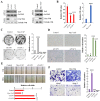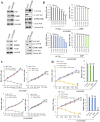Norcantharidin reverses cisplatin resistance and inhibits the epithelial mesenchymal transition of human non‑small lung cancer cells by regulating the YAP pathway
- PMID: 29901163
- PMCID: PMC6072289
- DOI: 10.3892/or.2018.6486
Norcantharidin reverses cisplatin resistance and inhibits the epithelial mesenchymal transition of human non‑small lung cancer cells by regulating the YAP pathway
Retraction in
-
[Retracted] Norcantharidin reverses cisplatin resistance and inhibits the epithelial mesenchymal transition of human non‑small lung cancer cells by regulating the YAP pathway.Oncol Rep. 2021 Jan;45(1):408. doi: 10.3892/or.2020.7830. Epub 2020 Nov 2. Oncol Rep. 2021. PMID: 33416151 Free PMC article.
Abstract
Non‑small cell lung cancer (NSCLC) accounts for >80% of all lung cancer cases, which are the leading cause of cancer‑related mortality worldwide. The clinical efficacy of available therapies for NSCLC is often limited due to the development of resistance to anticancer drugs, particularly to cisplatin (DDP). Norcantharidin (NCTD) is a traditional Chinese medicine used in the treatment of many types of cancer, to which patients do not develop resistance. The aim of the present study was to examine the potential synergistic effects of NCTD and DPP on the viability of the the DDP‑resistant NSCLC cell line, A549/DDP. We further explored the potential underlying mechanisms by examining the expression of the oncogene, Yes-associated protein 1 (YAP), whose activation was recently found to be associated with drug resistance. We further examined a series of human lung cancer cell lines and tissues from patients with lung cancer, which revealed that YAP activation contributed to lung cancer initiation, progression and metastasis, and was associated with a poor prognosis, and confering resistance against targeted therapies. Moreover, YAP expression was evaluated in the A549/DDP cells treated with NCTD, DDP, or both drugs. The combined treatment significantly sensitized the A549/DDP cells to DDP‑induced growth inhibition by reducing YAP promoter activity (based on transcriptional expression) and the expression of its target genes, connective tissue growth factor (CTGF) and cysteine rich angiogenic inducer 61 (CYR61). Furthermore, compared to the individual treatments, combined treatment increased cell apoptosis and senescence, and decreased epithelial‑to‑mesenchymal transition and the cell migratory and invasive ability. On the whole, our data indicate that the application of NCTD with reverses DDP resistance and thus, this combined treatment may have promising prospects for use in improving the outcome of patients with NSCLC.
Figures







Similar articles
-
Repression of YAP by NCTD disrupts NSCLC progression.Oncotarget. 2017 Jan 10;8(2):2307-2319. doi: 10.18632/oncotarget.13668. Oncotarget. 2017. PMID: 27903989 Free PMC article.
-
Niclosamide enhances the cytotoxic effect of cisplatin in cisplatin-resistant human lung cancer cells via suppression of lung resistance-related protein and c-myc.Mol Med Rep. 2018 Mar;17(3):3497-3502. doi: 10.3892/mmr.2017.8301. Epub 2017 Dec 18. Mol Med Rep. 2018. PMID: 29257330 Free PMC article.
-
FOXC2 promotes epithelial-mesenchymal transition and cisplatin resistance of non-small cell lung cancer cells.Cancer Chemother Pharmacol. 2018 Dec;82(6):1049-1059. doi: 10.1007/s00280-018-3697-2. Epub 2018 Oct 9. Cancer Chemother Pharmacol. 2018. PMID: 30302523
-
Molecular Mechanisms of Chemoresistance Induced by Cisplatin in NSCLC Cancer Therapy.Int J Mol Sci. 2021 Aug 18;22(16):8885. doi: 10.3390/ijms22168885. Int J Mol Sci. 2021. PMID: 34445588 Free PMC article. Review.
-
Norcantharidin in cancer therapy - a new approach to overcoming therapeutic resistance: A review.Medicine (Baltimore). 2024 Mar 1;103(9):e37394. doi: 10.1097/MD.0000000000037394. Medicine (Baltimore). 2024. PMID: 38428865 Free PMC article. Review.
Cited by
-
An Updated Understanding of the Role of YAP in Driving Oncogenic Responses.Cancers (Basel). 2021 Jun 21;13(12):3100. doi: 10.3390/cancers13123100. Cancers (Basel). 2021. PMID: 34205830 Free PMC article. Review.
-
New Insights into the Clinical Implications of Yes-Associated Protein in Lung Cancer: Roles in Drug Resistance, Tumor Immunity, Autophagy, and Organoid Development.Cancers (Basel). 2021 Jun 20;13(12):3069. doi: 10.3390/cancers13123069. Cancers (Basel). 2021. PMID: 34202980 Free PMC article. Review.
-
Association of the Epithelial-Mesenchymal Transition (EMT) with Cisplatin Resistance.Int J Mol Sci. 2020 Jun 3;21(11):4002. doi: 10.3390/ijms21114002. Int J Mol Sci. 2020. PMID: 32503307 Free PMC article. Review.
-
Metal-organic framework IRMOFs coated with a temperature-sensitive gel delivering norcantharidin to treat liver cancer.World J Gastroenterol. 2021 Jul 14;27(26):4208-4220. doi: 10.3748/wjg.v27.i26.4208. World J Gastroenterol. 2021. PMID: 34326620 Free PMC article.
-
The Roles of CCN1/CYR61 in Pulmonary Diseases.Int J Mol Sci. 2020 Oct 22;21(21):7810. doi: 10.3390/ijms21217810. Int J Mol Sci. 2020. PMID: 33105556 Free PMC article. Review.
References
Publication types
MeSH terms
Substances
LinkOut - more resources
Full Text Sources
Other Literature Sources
Medical
Research Materials
Miscellaneous

